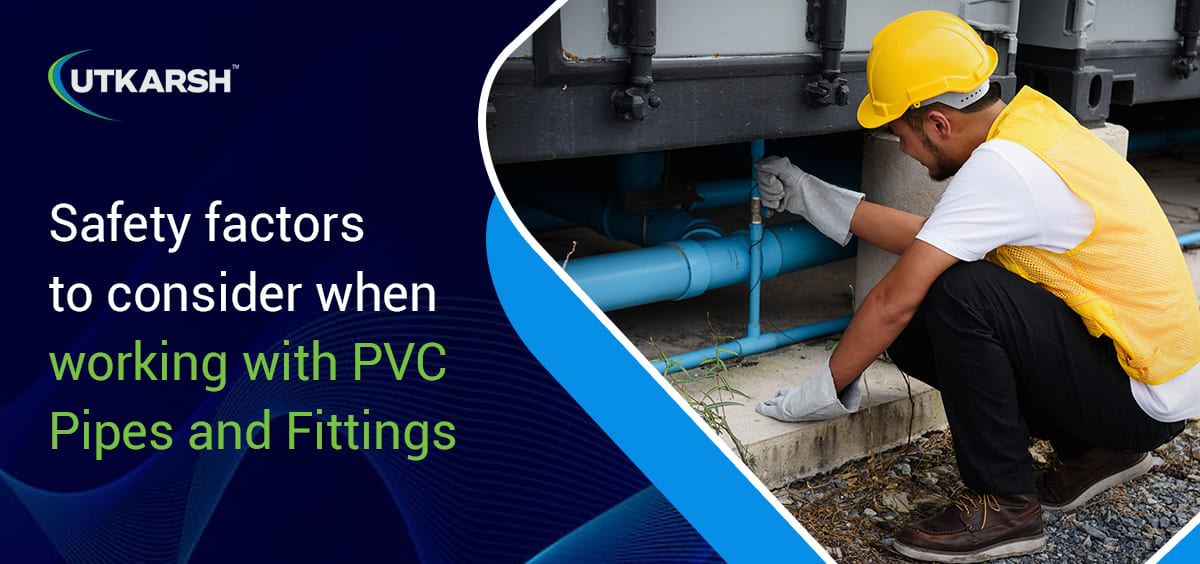Safety factors to consider when working with PVC pipes and fittings

PVC pipes and fittings have diverse applications in different sectors. They are commonly used in borewells and tubewells for water supply due to their corrosion resistance and ability to withstand high pressure. In residential buildings, PVC pipes and fittings are extensively used for plumbing systems, including water supply lines, drainage systems, and sewage systems, owing to their durability, affordability, and easy installation. Similarly, in commercial buildings, they are used for plumbing, as well as for HVAC systems. In industrial settings, they are widely used for transporting fluids, chemicals, and gases due to their chemical resistance.
While working with PVC pipes and fittings offers many advantages, it is essential to prioritise safety to minimise the risk of accidents and ensure the well-being of individuals involved in the installation, maintenance, and handling processes. Here, we share some of these safety factors to keep in mind when working with PVC pipes and fittings.
1. Personal protective equipment
- Safety glasses or goggles: They protect the eyes from potential debris, flying particles, or accidental splashes.
- Protective gloves: They prevent contact with solvents, adhesives, or sharp edges while handling pipes and fittings.
- Respiratory protection: In confined spaces or when working with adhesives or solvents, respiratory protection should be used to avoid inhaling harmful fumes or dust particles.
- Protective clothing: Long-sleeved shirts, pants, and closed-toe shoes should be worn to minimise the risk of cuts, abrasions, or chemical contact.
2. Proper lifting and handling techniques
- Use mechanical aids: When dealing with heavy or large-diameter pipes, appropriate lifting techniques should be used to avoid overexertion.
- Lift with the legs: When manually lifting pipes or fittings, it is advisable to bend the knees and use the leg muscles for lifting, thereby avoiding strain on the back. This proper lifting technique helps distribute the weight evenly and reduces the risk of back injuries or muscle strains. By bending the knees and relying on leg strength, individuals can ensure safer handling of pipes or fittings, promoting a healthy and injury-free work environment.
- Team lifting: For heavier or longer pipes, multiple individuals should be involved to distribute the load and reduce the risk of injury.
3. Fire safety precautions
- Avoid open flames: To avoid accidental ignition, it is important to refrain from using open flames or heat sources in close proximity to PVC pipes or fittings. This precautionary measure should be followed to prevent the PVC material from melting, deforming, or catching fire.
- Proper storage: PVC pipes and fittings should be stored away from potential ignition sources, such as electrical equipment, flammable materials, or direct sunlight.
- Emergency preparedness: Fire extinguishers should be readily available. Also, workers should be trained on their proper usage.
4. Cutting and installation safety measures
- Use appropriate tools: When cutting PVC pipes, it is important to use sharp and properly maintained tools that are specifically designed for this purpose, such as PVC cutters or hacksaws with fine-toothed blades. Excessive force or applying pressure at odd angles should be avoided, as it can lead to slips or accidents. Taking precautions and using the right tools can help ensure a safe and precise cutting process for PVC pipes.
- Secure pipes during cutting: To ensure clean and accurate cuts, it is advisable to use clamps or vices to secure the pipe during the cutting process. This helps prevent any movement or shifting of the pipe, which can result in uneven or imprecise cuts.
- Smooth rough edges: After cutting, any sharp or rough edges from the pipe should be removed after using a deburring tool or sandpaper to reduce the risk of cuts or abrasions.
- - Proper solvent application: When applying solvent cement, it is important to carefully follow the manufacturer's instructions. This includes adhering to the recommended amount of cement to be used and ensuring the necessary curing time before pressurising the system. By meticulously following the manufacturer's guidelines, individuals can ensure proper adhesion and effective sealing of PVC pipes and fittings. This helps prevent leaks and ensures the long-term durability and reliability of the plumbing system.
5. Respiratory protection
- Ensure good airflow: In order to maintain fresh air circulation and eliminate fumes or vapours, it is recommended to work in well-ventilated areas or use fans and ventilation systems. This ensures a healthier and safer working environment by preventing the accumulation of harmful substances or airborne contaminants.
- Use respiratory protection: When working in confined spaces or areas with inadequate ventilation, appropriate respiratory protection must be used such as respirators or masks.
Looking for high-quality PVC pipes?
Explore PVC casing pipes from Utkarsh India. Our pipes are manufactured using high-quality PVC compounds and serve as an ideal medium for extracting clean water from both deep and shallow bore wells. These pipes are specifically designed to meet the requirements of well casing and screening applications.
The supply range for our PVC pipes is as follows:
- Casing Medium: PVC pipes with a diameter ranging from 40 mm (1 1/2") to 400 mm (16") are available. These pipes are suitable for wells with depths ranging from 80 metres to 250 metres.
- Casing Shallow: PVC pipes with a diameter ranging from 150 mm (6") to 400 mm (16") are provided. These pipes are designed for wells with depths up to 80 metres.
- Casing Deep: PVC pipes with a diameter ranging from 250 mm (10") to 400 mm (16") are offered. These pipes are suitable for wells with depths above 250 metres up to 450 metres.
The casing PVC pipes are designed to meet the specific requirements of different well depths, providing reliable and durable solutions for borewell and tubewell applications.